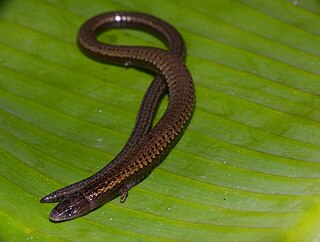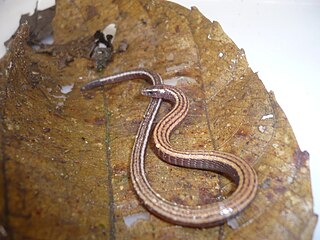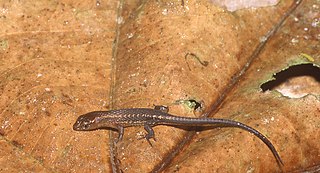
Bachia is a genus of lizards that belong to the spectacled lizards family.
Bachia heteropa is a species of "microteiid" lizard in the family Gymnophthalmidae. The species is native to the Caribbean and northern South America. There are two recognized subspecies.
Anadia blakei, also known commonly as Blake's anadia, is an endangered species of lizard in the family Gymnophthalmidae. The species is endemic to Venezuela.
Anadia hobarti, also known commonly as Hobart's anadia, is a species of lizard in the family Gymnophthalmidae. The species is endemic to Venezuela.
Arthrosaura tyleri is a species of lizard in the family Gymnophthalmidae. The species is endemic to Venezuela.
Bachia alleni is a species of lizard in the family Gymnophthalmidae. The species is endemic to the southern Caribbean.
Bachia barbouri, also known commonly as Barbour's bachia, is a species of lizard in the family Gymnophthalmidae. The species is endemic to Peru.

Bachia bicolor, the two-colored bachia, is a species of lizard in the family Gymnophthalmidae. It is found in Venezuela and Colombia.

Bachia dorbignyi, also known commonly as Dorbigny's bachia and lagarto-sem-pata in Brazilian Portuguese, is a species of lizard in the family Gymnophthalmidae. The species is native to central South America.
Bachia guianensis, the Guyana bachia, is a species of lizard in the family Gymnophthalmidae. It is found in Venezuela and Colombia.
Cercosaura steyeri is a species of lizard in the family Gymnophthalmidae. The species is endemic to Argentina.
Loxopholis ferreirai is a species of lizard in the family Gymnophthalmidae. The species is endemic to Brazil.
Loxopholis osvaldoi is a species of lizard in the family Gymnophthalmidae. The species is endemic to Brazil.
Loxopholis snethlageae is a species of lizard in the family Gymnophthalmidae. The species is endemic to Brazil.
Neusticurus medemi, also known commonly as Medem's neusticurus, is a species of lizard in the family Gymnophthalmidae. The species is native to northern South America.
Neusticurus racenisi, known commonly as Roze's neusticurus or the common Venezuelan water teiid, is a species of lizard in the family Gymnophthalmidae. The species is endemic to northern South America.
Yanomamia hoogmoedi is a species of lizard in the family Gymnophthalmidae. The species is endemic to Guyana.

Alopoglossus angulatus, known commonly as the northern teiid, is a species of lizard in the family Alopoglossidae. The species is endemic to northern South America.
Alopoglossus atriventris, known commonly as the keel-bellied shade lizard, is a species of lizard in the family Alopoglossidae. The species is endemic to northwestern South America.
Alopoglossus buckleyi, also known commonly as Buckley's shade lizard and Buckley's teiid, is a species of lizard in the family Alopoglossidae. The species is native to northwestern South America.



